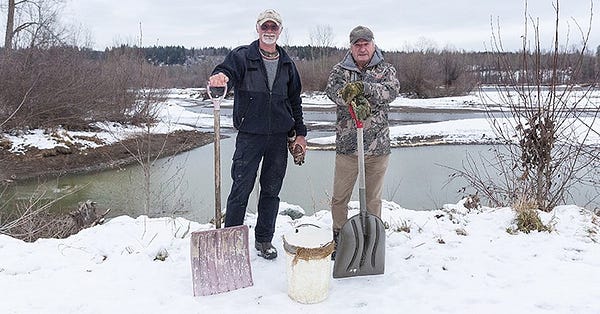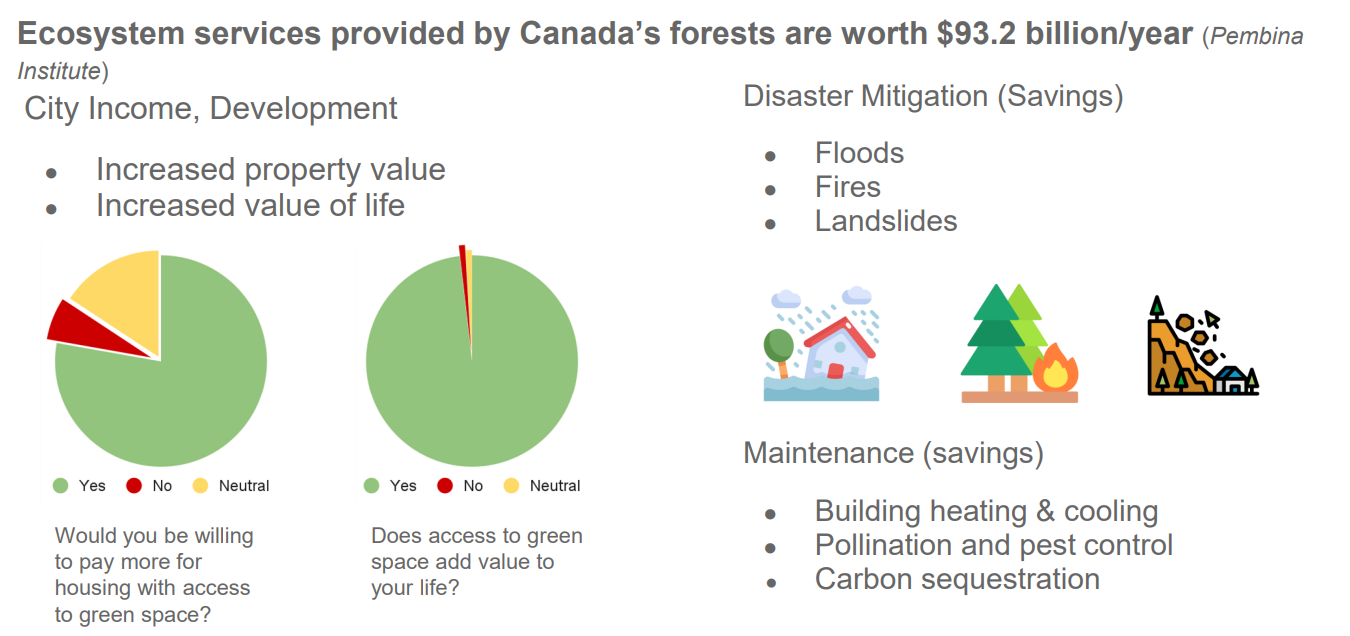Prince George was built on cutting down trees but maybe it's time to stop
And the great duck-feeding mystery
Happy Tuesday. Today’s newsletter has a mystery involving ducks. But first:
School District 57 (Prince George) is looking to change its name to not simply be “Prince George” since “The 50-year old name and visual identity references only one of the four communities served and currently does not reflect local First Nations on whose traditional territory our District is situated,” as a notice on their website states. You have until Dec. 16 to provide your feedback. The other communities served are Mackenzie, Valemount, McBride, Hixon, the McLeod Lake Indian Band, the Simpcw First Nation, and the Lheidli T’enneh First Nation.
Urban coyote stalks Prince George man while unloading groceries from cab.
What is the worst parking lot in Prince George? Here’s your chance to vote:


$3.5 million in cuts needed to keep tax hikes in the 3-4 per cent range
The finance and audit committee met to discuss the 7.22 per cent tax hike that would be needed in order to keep things running. They decided 7.22 per cent is a non-starter, as is 0 per cent because that would translate to $8.5 million in service cuts which would mean you’d be gutting core services like fire protection and road clearing. Instead, they’re hoping for about half that and staff are now tasked with finding a way to cut about $3.5 million in services for the new year.
Protect the trees (with a bylaw)


The first spring of the pandemic, when people were spending more time at home, I noted that one of the number one activities in my neighbourhood seemed to be people cutting down the trees in their yard. Over the course of the last three years, at least seven mature trees were toppled and when the heat of the summer sets in, the lack of shade is noticeable. Walking a few blocks to where my parents live, and there’s far more canopy cover, the temperature drops noticeably from “get inside to the fans” to “let’s lounge outdoors.”
This, in miniature, is an example of what researchers and policymakers refer to as heat islands — urban areas where a combination of pavement and a lack of greenspace combine to worsen the impacts of extreme heat events. And with this, a renewed interest in the importance of urban trees in mitigating these effects.
So why, when you visit the sites of new subdivisions being built around the city— usually in areas that were previously forests — has everything been clearcut, creating future heat islands?
That was the question behind one of a series of presentations UNBC students gave at Prince George city council last night focused on how we value — don’t value — greenspace.
If you are interested in exploring whether your neighbourhood is a heat island, here’s a cool tool for doing so.
The presentation from the 2nd year environmental policy class suggested the city update its tree protection bylaw which, having been first passed in 1995, is almost 30 years old and, as noted by the students, somewhat toothless. And those students looked at cities with more robust policies — namely Kamloops and Gibsons, both mid-sized B.C. cities — for some ideas on what an updated bylaw could look like.
Among their recommendations:
Update the city’s protected and recommended tree list (the current list leans heavily on trees from eastern Canada, including at least one invasive species);
Implement a two-for-one tree replacement policy (for every one tree removed, two must be planted to recognize the difference between mature and young trees in providing cover);
When trees are felled and can’t be replaced, requiring cash payments to plant new ones elsewhere.
Interesting ideas — but it also seems like any future policy would have to be pretty specifically worded as according to this piece from Kamloops, while some trees are being saved developers following the letter of the law are still able to cut. You can read the Kamloops policy here and the Gibsons one here.
The urban trees policy discussion was followed by another series of presentations from another 2nd year environmental policy class, this one titled “The Value of Nature.” The general theme of it was that people generally, especially young people choosing where to live, value access to greenspace but the development of the city as it grows doesn’t seem to recognize that (example: developers of new neighbourhoods clearcutting all the mature trees).
Council expressed a fair bit of interest in these ideas but in the end didn’t actually direct staff to revisit the trees bylaw or any other development bylaws that might result in more protection of urban space. Instead, they hope this will be covered in talks around the official community plan which will come next year. The official community plan is… fine… but it’s more of an aspirational document than a set of rules. We’ve seen countless examples of the OCP being ignored in favour of a new development the council of the day thinks is more important whereas it’s harder to get around zoning and bylaw rules but… that’s where things stand for now.
What is Simon Yu reading?
Here’s an interlude where I offer some observations about last night’s council meeting:
You know how you’re not supposed to have meetings about meetings? Well, most of last night’s meeting was about a meeting or, to be more precise, a hypothetical meeting with new premier David Eby. For nearly an hour council debated whether they should send an invite out to Eby and key cabinet ministers to come to Prince George to discuss the housing, mental health, addictions and crime situation that is now being characterized by councillors as an emergency. No one really disagreed they’d like to talk to him, what they disagreed on is whether they should tell staff to send out that invite right away, if they should wait until the new cabinet is announced on Wednesday, if first the invite should be diverted to the intergovernmental committee to be worked on (meeting date tbd) and then come back to council and various permutations of that. I got lost in the amdendments and amendments to the amdendments and honestly am not even sure what happened in the end. Bureaucracy!
What is Mayor Simon Yu reading? At one point during the meeting he mentioned it was Charles Montogmery’s 2013 book Happy City, now a full-on movement, which places a sense of community and belonging as the key measure of measuring a city’s success, rather than economic factors.
However, Mayor Yu didn’t seem particularly happy with how long the meeting took, expressing surprise at how late it was at least twice before things adjourned slightly after 9 p.m. Hope he gets used it to by the time the marathon public hearing sessoins lasting until midnight start up!
The great duck feeding mystery
OK, as promised…
Aside from the urban tree policy, the UNBC presentation that generated the most discussion was one that suggested something rather simple: We shouldn’t feed the wildlife!
The student observed that if you visit Cottonwood Island Park on any given day, you can find bird seed and other food strewn about what is supposed to be a protected wildlife area, which is not great. And most notable, she said, was the practice people have of feeding ducks, encouraging hundreds of them to spend the winter at the park rather than flying south.
Here’s where it got weird: A couple of councillors asked the bylaw manager — can we do something about this? And the bylaw manager said “it’s complaint driven,” meaning — we’ll respond if someone files a complaint. And this kind of blows my mind because the practice of feeding the ducks over the winter is not just random people going out with birdseed here and there — it’s a massive operation that has been going on for years, complete with newspaper and TV coverage calling for donations!


It’s run, apparently, through Ducks Unlimited volunteers, with food donations coming through a farm in Vanderhoof and people able to drop off their own through Spruce Capital Feeds. It’s a massive, daily operation involving buckets and shovels and… the city doesn’t know about this? Pacific Western Brewing donated 2,000 lbs of barley last year.
I will be honest, I just assumed this was all on the up-and-up because I couldn’t imagine that there could be a multi-year wildlife-feeding campaign going on in one of the city’s most visible parks without the city knowing about it, but after last night’s meeting… I’m not so sure? Council didn’t seem to know. City management didn’t seem to know. Everyone involved in the operation just wants to help the ducks, but has any of it actually been run through an actual wildlife management plan? Again, I had assumed yes but now, who knows? Bizarre.
OK, that’s it for today. If you have any insight into this, let me know.
Northern Capital News is a daily newsletter about life in Prince George. Please consider subscribing or, if you have, sharing with someone else.







Can we also talk about the people who feed the foxes near Cottonwood Park daily? Hungry, human-fed foxes pose a threat to children and small dogs, let alone themselves, as they cross roads looking for more free handouts. The ducks shouldn't be fed, but the fox feeding also requires a more serious highlight and bylaw intervention.